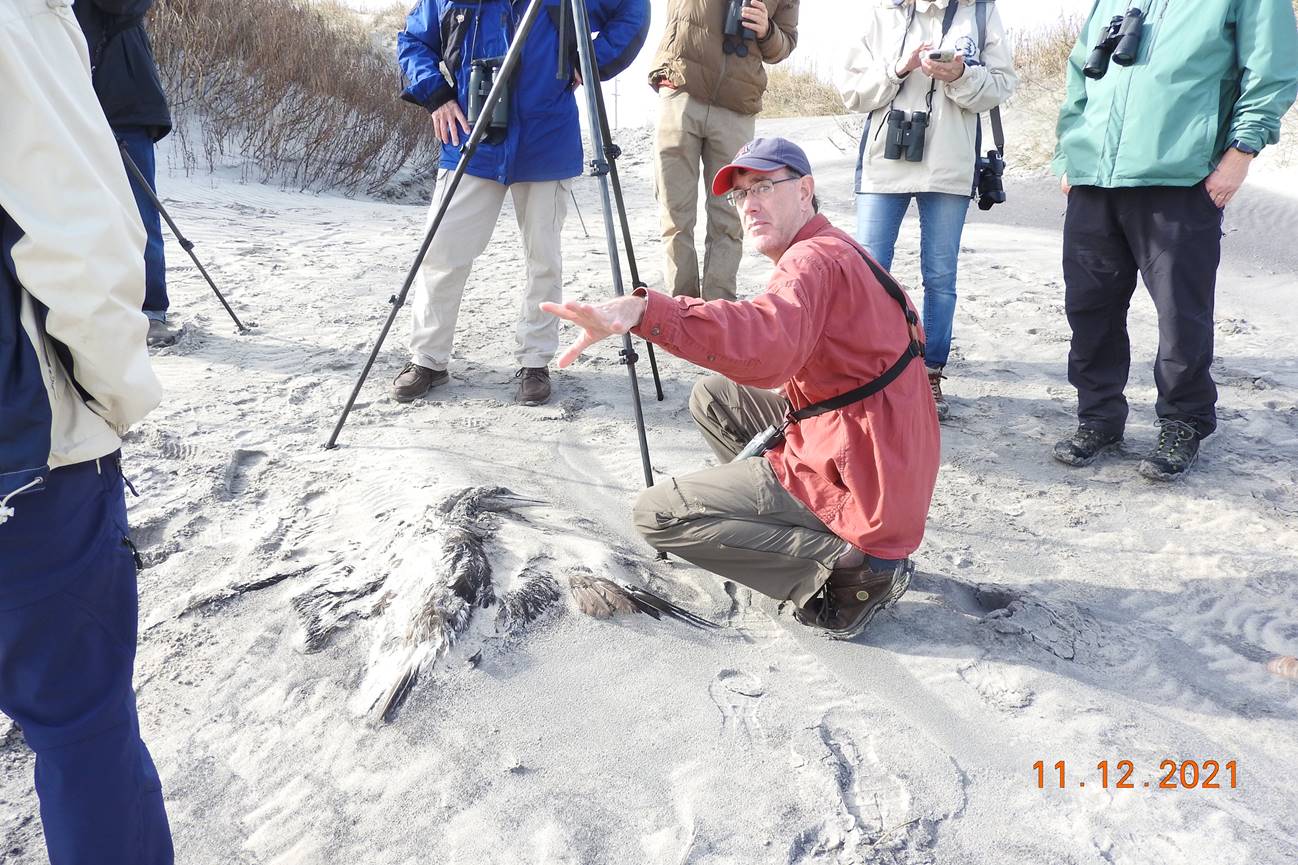Outer Banks Bonus Trips—December 2021
eBird trip reports:

December on the Outer Banks of North Carolina. Nor'easters, blowing salt and sand, hand warmers and hot chocolate after a wonderful day of birding? Or is it spring-like temperatures, calm wind, t-shirts, sunscreen, and a cold beverage after a wonderful day of birding?
In a La Nina year like the winter of 2021–2022, the latter was the case as coastal North Carolina bathed in a pool of warm air. In no way was this not appreciated by 22 members of the Carolina Bird Club who explored refuges, beaches, and marshes north and south of Oregon Inlet on the first two weekends of December.
The first in-person field trips sponsored by the Club in nearly two years due to the rapidly-becoming-endemic-pandemic were a big hit. Originally scheduled for the weekend of December 4–5, overwhelming response led to an "encore" the following weekend in order to accommodate all those who wanted to experience the Outer Banks in early winter.
Members met in the shadow of Bodie Island's historic 1872 lighthouse before traveling to the remnant inlet at what has affectionately become known as "Split Pea" (since it split Pea Island into two). Here, under calm, early morning conditions, each of the three maritime sparrows (Nelson's, Saltmarsh, and Seaside) perched up for inspection while hordes of Marsh Wrens chattered away. Shorebirds tottered back and forth on sandy flats, Palm Warblers and Savannah Sparrows vied with meadowlarks to stake prime territory on lightly vegetated ground, and overhead, fighter-like harriers and Cooper's Hawks could be compared with the United States Marine Corps AV-8B Harrier II aircraft shooting along the coast.
Leaving the sparrows to their morning routine, we moved north to the conjunction of New Field and South Ponds. Here was the star of the show, the "rarest", although not necessarily voted as favorite, bird of the weekends, Hudsonian Godwit.
One of the great attractions of North Carolina's coastal refuges in early winter in the sheer number of birds on the impoundments. Tens of thousands of ducks, geese, and swans made for an impressive sight, especially under sunshine and favorable weather. From time to time an eagle or other irritant would spook hundreds or thousands of birds into the air at once, always a jaw-dropping experience.
And while an earnest seawatch across from South Pond revealed little in the way of migrating ducks, sea or other, gannets put on a show, displaying nearly every possible plumage while harassing otherwise innocent schools of baitfish. And the entertainment extended onto the beach where a recently alive, but by then very much deceased, thresher shark allowed for close inspection. Staying in the carcass vein, we used the handy bodies of a young gannet and pelican to point out salient features, providing visual reinforcement to field marks often studied from afar.
Pushing north to Oregon Inlet, birders enjoyed the new "Bonner Fishing Pier", all that remains of the Bonner Bridge now that big brother Basnight Bridge soars over the sea. The pier may well become a prime birding spot in this and future winters, as it provides heretofore unavailable views of the new and old bridge abutments that often act as magnets for uncommon sea ducks. And instead of waiting for a Purple Sandpiper to decide on making a public appearance, folks can now look directly down on the haunts of these northern visitors. Indeed, "purps" were seen well on both trips. This also appears to be a great spot for Great Cormorant, just a great little bird that can be hard to find along the coast, but was rather easy to locate these weekends.
In addition to acting as an ad hoc picnic area, the spot ponied up an Audubon's form of the Yellow-rumped Warbler for first weekend's attendees, this form being quite uncommon in the state. First trippers also enjoyed a stunning, sunning bittern and somewhat casual walkabout from a Clapper Rail. This was followed by the main event, a slap-down, smackdown, titanic clash of Clappers. Two rails battling for marsh dominance. Who would reign supreme? Actually we don't know, they both looked the same.
Jennette's Pier always offers something, even if, as we experienced, that something is mainly scenic. Shrimp trawlers plied trade just offshore, grackles examined spotting scopes hopefully, and we continued to wonder why Rock Pigeon continues to have a red circle in eBird when there is a permanent residency of some two dozen birds.
Optional evening dinners were well-attended, one at Blue Water Grill and the other at Basnight's Lone Cedar. Here, over aperitifs and appetizers, birds were catalogued, considered, and debated. Each member offered their "top bird of the day", and more than a little amount of reportedly-local seafood was enjoyed.
Sundays followed Saturdays, as they often do, with more birding. Clean-up runs along the coast helped to fill in missing, but expected, species. Rolls of film went to memorializing avocets, Tundra Swans with landing gear engaged, and other avifaunal wonders. After lunching at White's Service Station, often an experience in and of itself, the groups repaired to Alligator River NWR for a drive through and around the fields and impoundments, although in this drought-stricken season, fields often doubled for impoundments. On the first weekend Black Bears frolicked in the sole accessible corn field, while on the second they were strangely absent.
But present at the end of both trips was agreement that early winter along the coast of northeastern North Carolina is indeed a magical time, full of whirring wings, wind-up toy shorebirds, skulking sparrows and, so important in this day, a chance to get together and enjoy what we all share, a love of the outdoors and birdlife that make North Carolina a great place to live, visit, and bird!

